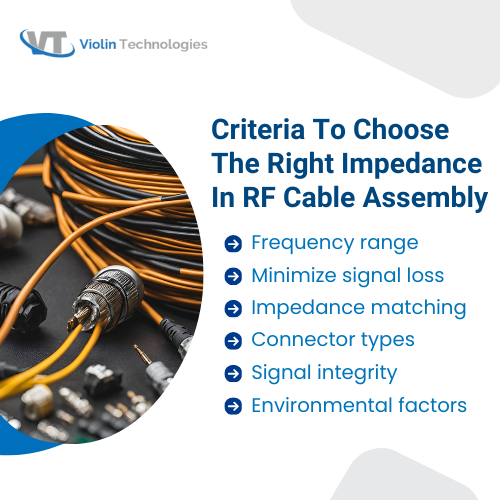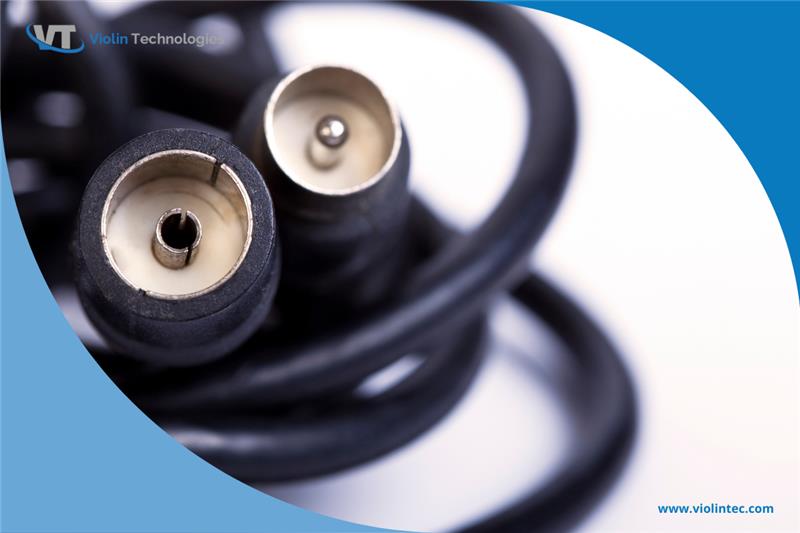In the following sections, we will explore the intricacies of frequency, impedance, and connector types, equipping you with the necessary insights to choose the most suitable cable assembly for your needs.
Key Takeaways
- Selecting the right impedance prevents signal loss and enhances transmission efficiency for stable connectivity.
- Choose connectors that meet both technical specifications and environmental needs for durability and fit.
- Choose a frequency range that aligns with your device’s performance requirements to ensure optimal signal quality.
- Evaluate operating conditions like temperature, moisture, and vibration to select materials that support long-lasting performance.
Cable Assembly Basics
A cable assembly consists of a collection of wires or cables arranged to convey electrical signals within a regulated setting. In RF applications, cable assemblies are critical in transferring radio frequency signals between essential components while minimizing signal loss and interference.
Choosing the right cable assembly involves understanding the system’s requirements for frequency spectrum, signal integrity, impedance matching, and environmental conditions. Coaxial cables are commonly used in RF cable assemblies due to their ability to carry high-frequency signals while maintaining signal quality efficiently.
Explore the top Custom Cable Manufacturers in India. They offer tailored solutions to meet your unique wiring and connectivity requirements across various industries.
Criteria To Choose The Right Impedance In RF Cable Assembly
1. Frequency Range
The frequency range of a cable assembly is crucial for selection, as different coaxial cables are rated for specific frequencies. Higher frequencies require cables that can maintain signal consistency and reduce signal loss over the length of the cable.
For example:
- Low-frequency applications: For frequencies under 1 GHz, a standard coaxial cable may be sufficient.
- High-frequency applications: Cables designed for frequencies up to 18 GHz (or even higher) are typically needed. High-frequency signals are more prone to loss and require cables with lower attenuation and better shielding.
2. Minimize Signal Attenuation And Loss
Signal attenuation is the gradual reduction in signal strength over distance. For efficient transmission, the cable should minimize signal attenuation and loss. In contrast, signal weakening refers to the amount of signal that is dissipated or absorbed as it travels through the cable. Selecting high-efficiency cables with appropriate insulation and shielding materials is critical for maintaining signal quality.
For longer distances or high-power applications, you may also need to select cables with reinforced outer conductors and an enhanced insulating layer to prevent signal degradation.
Discover the leading Cable assemblies and electrical Contract manufacturing companies in Chennai, providing customized solutions for diverse industrial applications.
3. Impedance Matching
In RF systems, impedance matching between the cable and the connected components is crucial for avoiding signal reflections and ensuring maximum power transfer. The two most common impedance standards for coaxial cables are 50 ohms and 75 ohms.
- Fifty ohms: Typically used in RF communication systems, cellular networks, and wireless applications.
- Seventy-five ohms: Commonly used in video signal transmission and some telecommunications applications.
The cable assembly’s impedance should match the impedance of the connectors and devices to which it is connected. Impedance mismatching can lead to signal reflections, loss, and degraded system performance.

4. Connector Types
Connector types are an integral part of the performance of an RF cable assembly. Common RF coaxial connectors include:
- SMA Connectors: Small, precision connectors used for frequencies up to 18 GHz and beyond. They are known for high-performance connections and are widely used in mobile and wireless communication systems.
- BNC Connectors: Widely used in low-frequency applications, such as test equipment and video systems, where quick connect/disconnect capability is needed.
- N-Type Connectors: These are suitable for high-power and high-frequency applications, with an operating range of up to 11 GHz or higher.
- TNC Connectors: A threaded version of the BNC, ideal for environments where vibration or shock is a concern, and can operate up to 11 GHz.
The choice of coaxial connectors depends on the frequency interval, power capacity, ecological conditions, and system physical size limitations. High-frequency applications will typically require connectors like SMA, while BNC or TNC may be used for lower-frequency or more rugged applications.
5. Signal Integrity And System Performance
Maintaining signal integrity is crucial in RF systems, especially when transmitting increased frequency signals over longer distances. The quality of the cable assembly, including the materials used for the outer conductor, insulation, and center conductor, will directly affect the overall system performance.
Choosing the right cable type, such as flexible cables, can help maintain signal quality by minimizing insertion loss and signal degradation. The bend radius of the cable is another important factor, especially in applications where cables need to be routed through tight spaces.
6. Environmental Factors And Power Handling
Cable assembly must also be able to withstand the environmental factors in which they will be used. This includes considerations such as:
- Temperature Range: Make sure that the cable and connectors can function effectively within the specified temperature range without affecting their performance.
- Vibration and Shock: For applications in industrial or military environments, select connectors and cables that can handle vibration and shock.
- Power Rating: Choose cables and connectors that can handle the system’s power requirements without overheating or causing signal degradation.
N-type connectors are a good option for high-power applications, while SMA connectors are preferred for applications with lower power but higher frequency requirements.
Partner with leading Contract Manufacturers in India who deliver scalable and cost-effective manufacturing solutions tailored to your business needs.
Selecting The Right Coaxial Cable
When selecting the right coaxial cable, consider the following key characteristics:
- Frequency requirements: Ensure the cable can handle the maximum frequency needed for your application.
- Cable length: Longer cables tend to have higher signal loss, so choosing low-loss cables is important.
- Power handling capability: Ensure the cable can handle the maximum voltage or current without degrading.
- Environmental factors: Take into account the operating conditions, including factors like temperature, humidity, and potential exposure to chemicals or moisture.
Conclusion
Choosing the appropriate cable assembly for your RF application necessitates a thorough evaluation of multiple factors, such as frequency bandwidth, impedance matching, connector type, environmental conditions, and power handling capability. By grasping your application’s specific needs and selecting the right cables and connectors, you can achieve efficient signal transmission and maximize system performance.
Frequently Asked Questions
What is the difference between 50-ohm and 75-ohm coaxial cables?
The main difference between 50-ohm and 75-ohm coaxial cables lies in their impedance. 50-ohm cables are typically used for RF applications, while 75-ohm cables are preferred for video and broadcast signals.
Can I use the same connector for different frequencies?
Yes, the same connector can be used for different frequencies, but its performance may vary depending on the frequency range and specifications of the application.
How do I minimize signal loss in a long coaxial cable run?
To minimize signal loss, use low-loss cables with appropriate shielding and insulation. Additionally, consider using signal amplifiers or repeaters for very long cable runs.
What role does the bend radius play in cable selection?
The bend radius is crucial in cable selection as it determines the minimum curve a cable can make without risking damage or signal loss.

Rasmita Patro
About the Author
Meet Rasmita Patro, a content writer, a former teacher, and a former HR with a passion for storytelling, creating compelling content that engages and informs readers. She has a Master’s in Economics and an MBA degree in Human Resources. Her expertise spans a variety of industries, including finance, healthcare, technology, and others. She has a particular inclination toward crafting blog posts, articles, and social media content that resonates with the target audience. She loves reading different genres of books, love to experiment with cooking, and listening to soothing music.

